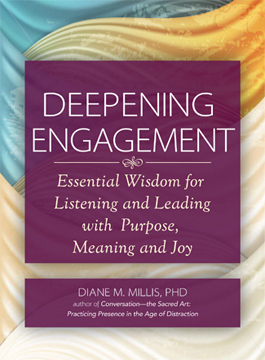Editor’s note: In her new book, “Deepening Engagement: Essential Wisdom for Listening and Leading with Purpose, Meaning and Joy,” leadership consultant and coach Diane M. Millis offers advice on how we can engage more deeply with our true selves, one another and the communities in which we live and work. In the following excerpt, she explains how to ask meaningful questions.
Pause
“No other person can ever chart a course for you, but a friend and a host who is really present can at times firm up what you in your own deepest heart of hearts have already felt drawing at you.”
--Douglas Steere, “On Being Present Where You Are”
Ponder
“Have you ever told your story before?”
“No.”
“Why not?”
“No one ever asked.”
Dave Isay wanted to change that. In 2003, he set up a recording booth in Grand Central Station and launched the StoryCorps Project. Isay had learned, through his work as a documentary radio producer, that a microphone gives people permission to ask questions of others that they normally wouldn’t ask. Since then, close to fifty thousand people have been asked by a friend or family member to share their stories in one of the StoryCorps recording booths found throughout the country. Isay reflects in his book “Ties That Bind: Stories of Love and Gratitude from the First Ten Years of StoryCorps” (New York: Penguin, 2013), “We can discover the most profound and exquisite poetry in the words and stories of the noncelebrated people around us, if we just have the courage to ask meaningful questions and the patience to listen closely to the answers.”
 Asking meaningful questions requires courage because asking is such a countercultural activity in our tell culture, observes Edgar Schein in his recent book, “Humble Inquiry: The Gentle Art of Asking Instead of Telling” (San Francisco: Berrett-Koehler, 2013). Schein has taught and studied organizational dynamics throughout his career and observes,
Asking meaningful questions requires courage because asking is such a countercultural activity in our tell culture, observes Edgar Schein in his recent book, “Humble Inquiry: The Gentle Art of Asking Instead of Telling” (San Francisco: Berrett-Koehler, 2013). Schein has taught and studied organizational dynamics throughout his career and observes,
Our pragmatic, problem-solving culture values people who know things and tell others what they know. In such a culture, having to ask is perceived to be a sign of weakness or ignorance. Asking temporarily empowers the other person in the conversation and temporarily makes me vulnerable.
Those with the most authority tend to tell more often than ask, and those who ask are often viewed as either naive or bothersome or both. Case in point: Just last week, a client recalled how her boss told her not to ask so many questions during meetings. He insisted, “It makes it seem as if you don’t know what you’re doing.” Yet the primary benefits of asking, according to Schein, are that we generate better ideas, make fewer errors in judgment, and increase our agility.
Our tell culture is so pervasive that many of the questions we do ask are just another form of telling. Our questions reveal our assumptions, reflect our projections, and relay our agendas. In asking questions, we often have an answer already in mind. For example:
- Do you really think that [x, y, or z] is a good idea?
- Have you always been so overly concerned with what your boss thinks of you?
- Have you thought about using this approach instead?
We tend to offer thinly veiled advice through our questions instead of seeking to better understand another’s perspective.
The remainder of the questions we ask are generally conventional in nature. They require very little effort to ask and even less effort to answer. Conventional questions are designed to elicit information. They take on predictable forms at all stages of our lives:
- How do you like school? (we ask the children we meet).
- What is your major? (we ask the students we meet).
- What do you do for a living? (we ask the adults we meet).
When I’m talking with someone whose repertoire is limited to conventional questions, I often feel like I’m a Pez dispenser (remember those wonderful candy containers?). With each subsequent question, I pop out another prefabricated Pez tablet. All the while, the energy in my container, along with my engagement in the conversation, diminishes. What would happen if we asked instead:
- What do you like most about the grade you are in?
- What are you enjoying learning about this semester?
- Where are you finding joy in your life these days?
Such questions cannot be answered automatically. They require real-time reflection. When asked, the other person may respond, “I need to think about that.” Or “I’ve never thought about that before.” You know you’ve asked a really good question when you hear that response. And that is the second part of Dave Isay’s wisdom: Not only do we need to have the courage to ask meaningful questions, but we also need to have the patience to listen closely for the answers.
Asking good questions requires courage, patience, and, as Edgar Schein underscores, skill and art. He defines humble inquiry as “the skill and the art of drawing someone out, of asking questions to which you do not already know the answer, of building a relationship based on curiosity and interest in the other person.”
I’ve found the following guidelines especially helpful in developing the skill and practicing the art of asking heart-awakening questions:
- If you think you already know how the other person will respond, try to come up with a different question.
- Begin your question with words and phrases like these: how, what, where, when, in what ways ... or tell me more about ... Open-ended questions tend to evoke more robust responses because they cannot typically be answered yes, no, or in a few words.
- Pay attention to key words and phrases that seem to have particular energy and meaning for those with whom you are speaking and incorporate their language into your question. For example, What are you getting jazzed about these days? What hit you at your core in that meeting? Tell me more about what floats your boat in this design.
- Maintain awareness of a person’s nonverbal responses and incorporate your observations into your questions. For example, I notice how your eyes lit up when you talked about yesterday’s presentation. What was the highlight of that presentation for you?
- Go beyond the first response. Encourage others to keep noticing and naming what’s at the core, the heart of the matter for them. For example, Tell me more about why that is important to you.
- Continue to listen patiently as our deepest truths are often difficult to put into words quickly and continue to emerge over time.
What is a question you would most like to be asked and by whom?
Practice
This day, in each of the conversations you participate in, try to ask at least one heart-awakening question. As much as possible, tailor your question to the unique aspects of the person -- being attentive to his or her manner of speaking, preferred phrases, and expressions.
Excerpt is from “Deepening Engagement: Essential Wisdom for Listening and Leading with Purpose, Meaning and Joy” © 2015 Diane M. Millis. Permission granted by SkyLight Paths Publishing, www.skylightpaths.com.








